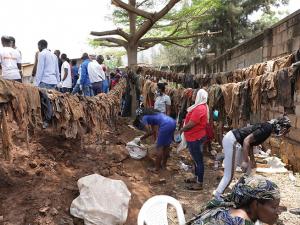
Remains of 200 Genocide victims to be interred in Kigali
Remains of more than 200 victims of the 1994 Genocide against the Tutsi are set to be accorded decent burial this Thursday 26th following a week of exhumation from a previously unknown mass grave in a Kigali city suburb.
The remains, which were retrieved from a mass grave in Rwezamenyo Sector, Nyarugenge District, will be interred at Nyanza Memorial Site in Kicukiro District.
The remains were unearthed from the courtyard of a house that formerly belonged to Jean Baptiste Rwagasana, a Tutsi who was killed along with many family members during the Genocide.
According to Stella Mbabazi, the Executive Secretary of Rwezamenyo Sector, works to unearth the bodies have been ongoing since Friday last week with the help of the district administration as well as other authorities, and basing on the shoes and clothes that have been found so far, she said that over 100 victims have at least been found.
Explaining the sad story of what transpired, Carine Karambizi, whose parents are among the victims, said that in April 1994, many people who died at this house had come seeking protection because the family had many boys and men who could help defend them against the Interahamwe.
“During the Genocide, many family members as well as other Tutsi came here because they knew that when people are many, they are stronger,” she said.
“There were also strong boys at home who could fight for us when the attackers came. So, many people had come here by April 7, a day before we were attacked by the military and the Interahamwe who killed my parents and other family members among many other people.”
Karambizi and other family members who survived did not know that the bodies of their loved ones were buried in this courtyard by the attackers until in May this year when she got a clue from a lady who survived from the same home and is currently living in France,
“When we met, she gave me a detailed account of what happened. Somewhere amid the conversation, she mentioned that she had fallen into a pit in the compound where many bodies had been thrown. This made me suspect that the bodies might not have been carried away by the killers but rather buried here,” she said.
Karambizi says that when she went back to Belgium, she talked with other family members and figured out where the pit might be located in the courtyard of her childhood home, and prepared to come and try to search for the remains.
With the digging work done so far, Karambizi says they been able to identify her father basing on a shirt which he was wearing when he was killed; one of her siblings basing on a shoe, and another young boy – a relative of hers.
Mbabazi expressed disappointment over people who know where Genocide victims were buried but are reluctant to tell their relatives.
“We request them to come out and speak the truth. Information that helped us in the discovery of the remains in this home did not come from the neighbours around. It was a person in France who gave us information. Every year we remember the Genocide in this cell but no one had told us that there are bodies buried here,” she said.
“We played a part in the dark history of our country, and we need to play a part in changing it.”
The Government and survivors have underlined the importance of retrieving the remains of Genocide victims from places they were dumped, and given decent burial.
Nyanza memorial is home to more than 96,000 Genocide victims most of whom were interred there this year after they were exhumed from mass graves in the Kabuga neighbourhood in Kicukiro District.
